The iPad Air Review
by Anand Lal Shimpi on October 29, 2013 9:00 PM ESTGPU Performance
Since the iPad Air uses the same A7 silicon as the iPhone 5s, it also uses the same on-die GPU as the 5s: IMG’s PowerVR G6430. This is a 4-cluster configuration of IMG’s latest graphics hardware, running at some relatively high frequency. I already went into some detail on the G6430 in our 5s review so I won’t rehash that here, but we’re basically looking at a shift to a more efficient scalar architecture.
I still don’t have confirmations of clock speeds, but I believe we’re looking at a max GPU clock of around 450MHz. As you’ll see from the results below, there’s a small difference in performance between the iPad Air and iPhone 5s in terms of peak GPU performance - implying very similar clocks. The difference is the iPad Air should be able to sustain its max frequency longer than the iPhone 5s can.
| Mobile SoC GPU Comparison | ||||||||||||
| PowerVR SGX 554MP4 | PowerVR G6430 | PowerVR G6430 | ||||||||||
| Used In | iPad 4 | iPhone 5s | iPad Air | |||||||||
| SIMD Name | USSE2 | USC | USC | |||||||||
| # of SIMDs | 32 | 4 | 4 | |||||||||
| MADs per SIMD | 4 | 32 | 32 | |||||||||
| Total MADs | 128 | 128 | 128 | |||||||||
| GFLOPS @ 300MHz | 76.8 GFLOPS | 76.8 GFLOPS | 76.8 GFLOPS | |||||||||
| GFLOPS as Shipping | 68.1 GFLOPS (?) | 115.2 GFLOPS | 115.2 GFLOPS | |||||||||
Since we’re talking about an A7 here and not an X-series SoC, there’s still only a 64-bit wide memory interface. As memory bandwidth is a key enabler of GPU performance I was curious to see how GPU performance compared to the outgoing iPad 4 with its much wider memory interface. Do keep in mind that the A7 does include a large system cache on-die, which can help improve effective memory bandwidth.
GFXBench 2.7
We'll start our GPU performance analysis with a look at low level results using GFXBench/GLBenchmark 2.7. The low level tests, particularly the offscreen ones, should give us some idea as to whether or not there's any increase in GPU frequency for the iPad Air vs. iPhone 5s implementations of A7.
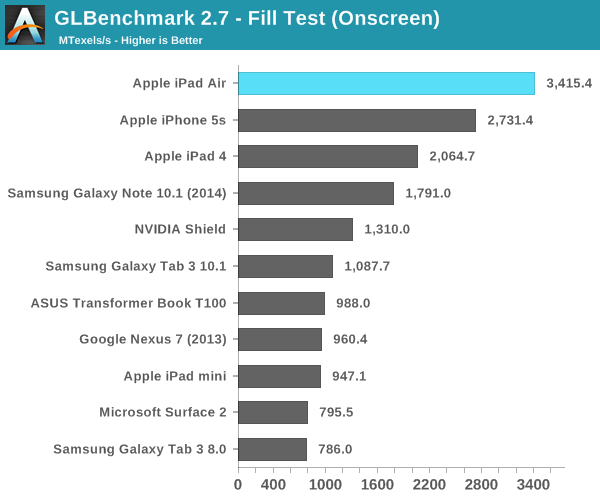
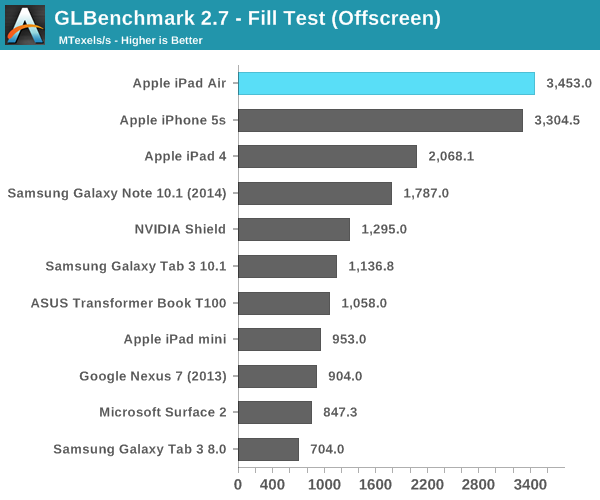
Looking at the fill rate results, there's a 4.5% increase in performance compared to the iPhone 5s. That could be the magnitude of clock increase that we're seeing between A7s. Apple could very well be relying on more thermal headroom in the iPad Air to provide any real world GPU performance advantages over the iPhone 5s.
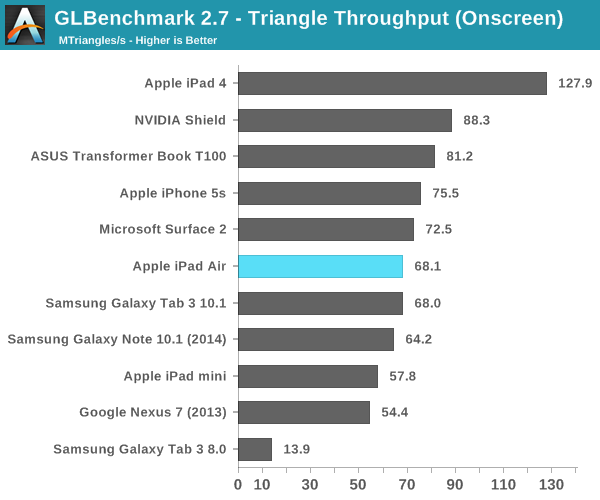

We see an even smaller gap between the Air and 5s in the triangle throughput tests (2.9%). There doesn't seem to be any substantial difference in GPU frequency between A7 implementations here. The regression in triangle rate performance compared to the iPad 4 is explained by differences in how Series 6 and Series 5XT GPUs scale in width. Whereas 5XT replicated nearly the entire GPU for "multi-core" versions, multi-cluster versions of Rogue only replicate at the shader array. The result? We don't see the same sort of peak triangle setup scaling we did back on multi-core 5XT parts. I'm not sure I'm particularly happy with the magnitude of the regression here, but I haven't seen any real world cases where it matters yet.
Next up are the game simulation tests. We'll start with the more strenuous of the two: T-Rex HD.
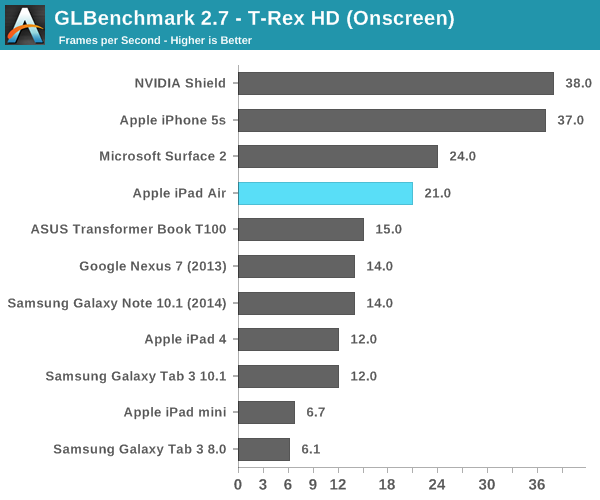
Here we get closer to Apple's claims of a 2x increase in performance. The iPad Air delivers 75% more performance than the iPad 4 in this test. Once again the iPhone 5s pulls ahead but that's because the onscreen tests render at display resolution, which is lower on the 5s.
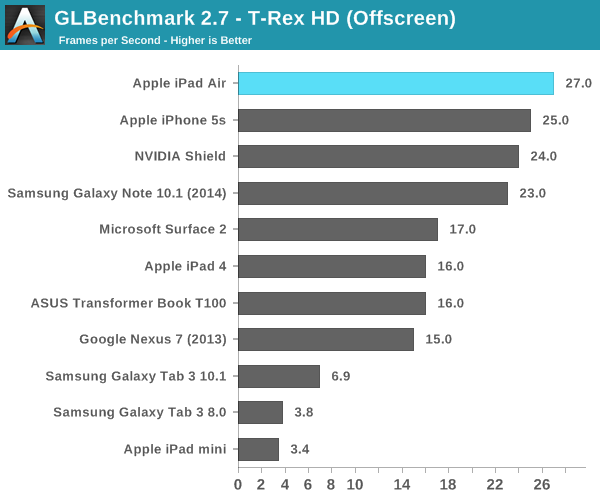
Offscreen performance sees similar scaling: ~69% better performance compared to the iPad 4.
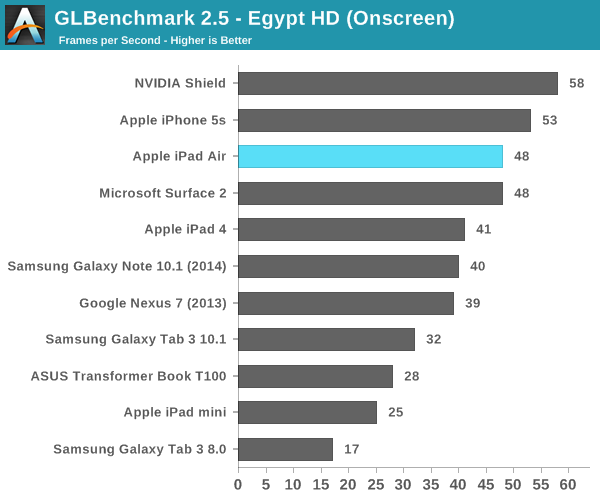
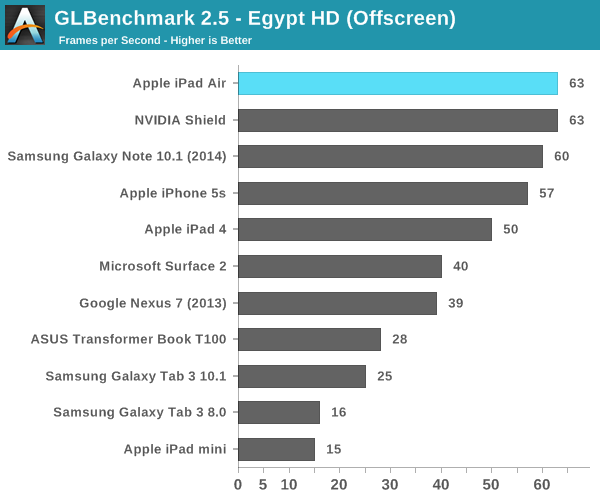
3DMark
We're once again running 3DMark's newest Unlimited mode which does its best to run independently of v-sync and at a standard resolution across all devices. I've also included 3DMark Extreme results below that feature a few more comparison points.
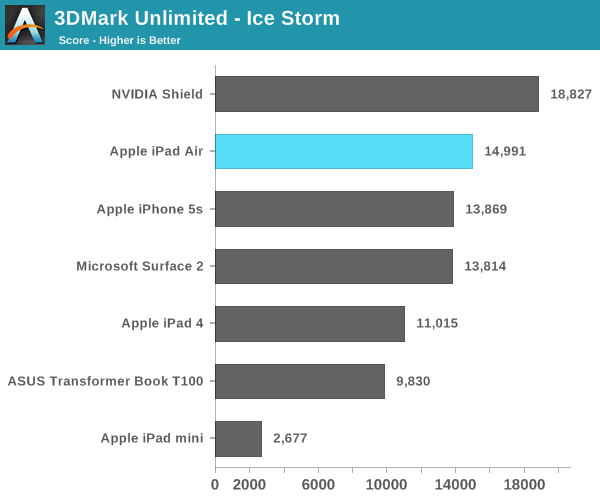
The overall Ice Storm scores show a 36% improvement in performance over the iPad 4 and an 8% increase compared to the iPhone 5s. Given the CPU frequency advantage of the A7 in the Air vs. the iPhone 5s, I'm guessing that's why we're seeing the performance gap we are here.
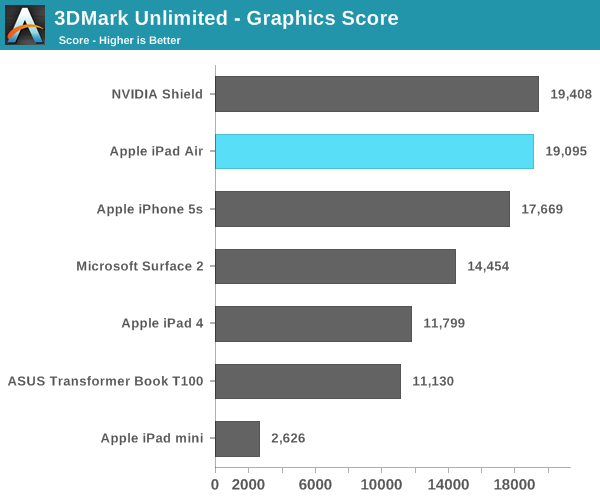
If we focus exclusively on the GPU tests (which themselves are still CPU bound), the iPad Air's performance advantage over the iPad 4 grows to over 60%.
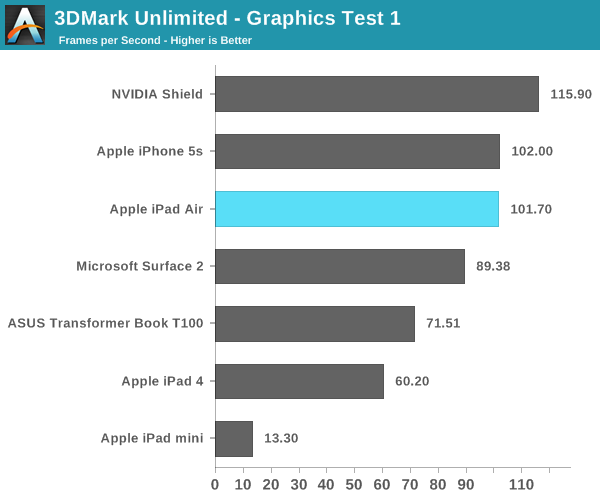
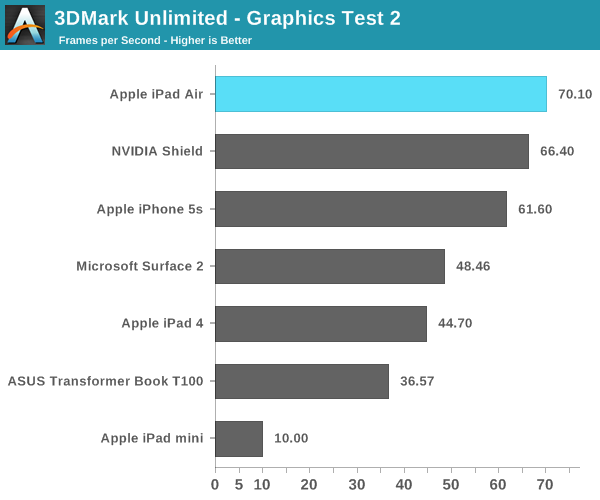
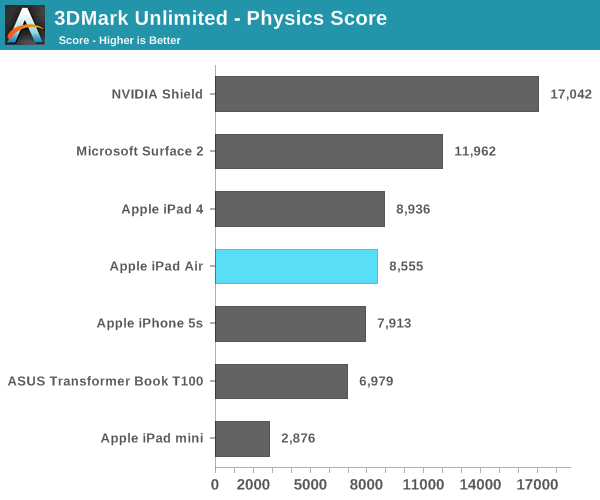
I'm still not entirely sure what's going on with the 3DMark Physics test, but we've seen this two reviews in a row now where Cyclone showed no performance increase at all compared to Swift despite this being largely a CPU test.
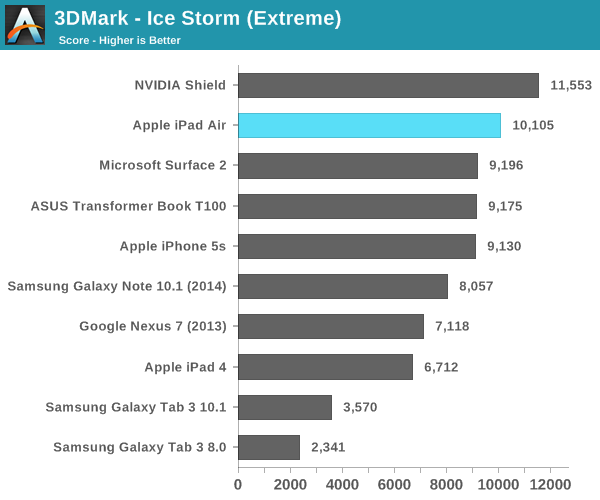
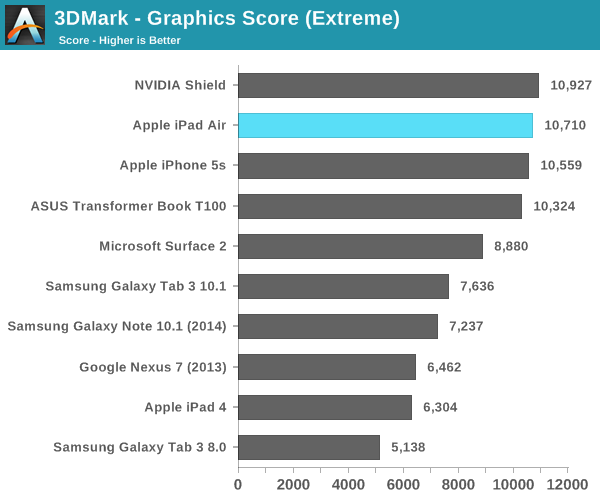
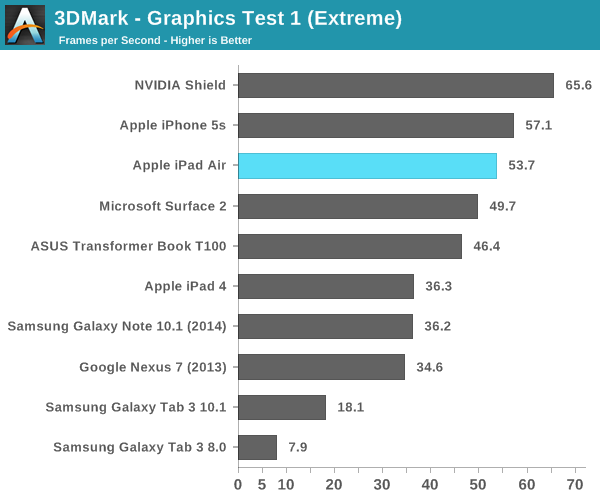
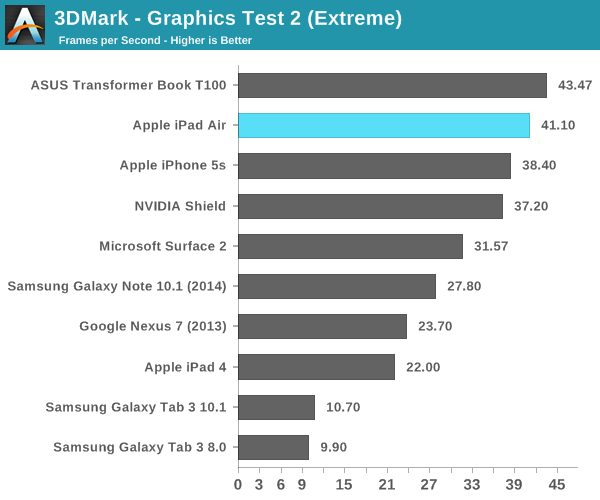

Basemark X
Basemark X is a new addition to our mobile GPU benchmark suite. There are no low level tests here, just some game simulation tests run at both onscreen (device resolution) and offscreen (1080p, no vsync) settings. The scene complexity is far closer to GLBenchmark 2.7 than the new 3DMark Ice Storm benchmark, so frame rates are pretty low.
I'm still having random issues with Basemark X reliably running both on and offscreen tests on iOS 7. Unfortunately I could only get onscreen results for the iPad Air, which came in at 46% faster than the iPad 4. Note the iPad mini and iPhone 5s benefit from having lower native resolutions here, which is why they perform so well.
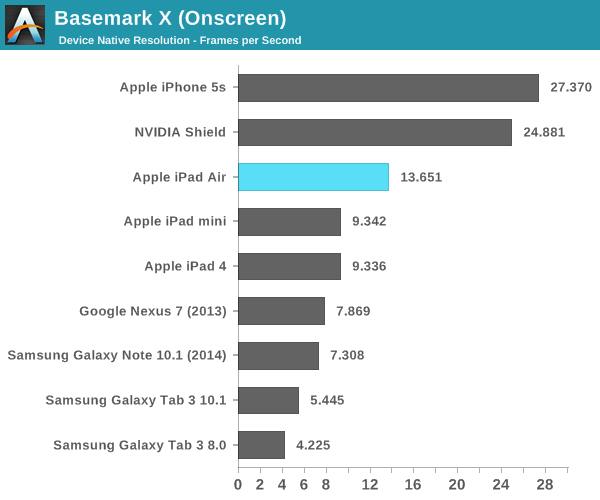










444 Comments
View All Comments
Fx1 - Wednesday, October 30, 2013 - link
The only issue i have with this review is that you took 10 whole pages to basically review the same ipad that has been around for years which is just slightly faster and slimmer than last years. Its a locked down boring tablet for kiddy users.Streamlined - Wednesday, October 30, 2013 - link
That's funny because I'm a financial analyst and the most popular tablet among professionals who use their tablet for WORK in Fortune 500 level companies is the ipad.darkcrayon - Thursday, October 31, 2013 - link
Right, the tablet with the most compelling apps and arguably the most powerful hardware is surely boring and for kiddy users. By your laughable standard, pretty much any computer in any category is the same as the last several.gattacaDNA - Wednesday, October 30, 2013 - link
As far as I know, Apple has not begun printing US currency. So everyone is entitled to spend their $ on whatever tablet or other device strokes their fancy / fantasies. All this lambasting and "mine's bigger than yours" is a childish waste of time. Nearly every review in every medium has some sort of bias. Hell you demonstrate bias every day when you choose who to eat a meal with - get over it. Buy what devices you want and the market and stock prices will decide what futures are delivered - all are viable until proven otherwise. Peace.gnx - Wednesday, October 30, 2013 - link
1 lbs is the threshold for easy to hold in hand. I felt so after using a iPad and a Galaxy Tab 10.1 and then Galaxy Tab 8.9 and iPad2.In terms of form factor, personally, I though Samsung already had the best product in 2011 with the Galaxy Tab 8.9: screen real estate comparable to an iPad/iPad2 (the same height in portrait, just a bit more compact in width) but lighter and thinner (under 1 lbs). So I was dismayed to see Samsung not follow up with a successor to the Galaxy Tab 8.9, while Apple went for heavier and thicker with iPad3 & iPad4. Smaller tablets like the Galaxy Tab 7.7, Nexus 7 and iPad Mini (7.9)/Galaxy Note 8.0 all sacrificed screen space too much, for someone like me who reads a lot of documents on them.
Personally, cause I'm frustrated with the lack of widgets on iOS, I am partial to Android. But if Google or Samsung or Asus don't come up with a 8.9 or 10.1 under 1lbs, the iPad Air may be my only choice for an upgrade .....
Death666Angel - Wednesday, October 30, 2013 - link
Amazon HDX 8.9" not for you? :) The software does have issues, but it checks all the right boxes. Might work for you. Either the last one for price and good-enough performance of this years with higher prices (still lower than iPad) and higher performance, better specs to go with it.gnx - Thursday, October 31, 2013 - link
I also love the form factor of the Kindle HDX 8.9 - superb dimensions and weight in my opinion. But I have to sadly admit I am also tied to several google apps, namely, gmail, google voice, google calendar and a few others, and though both iOS and Android provide support, forked Amazon Fire OS doesn't ... this is more Google's call than Amazon's fault, but admittedly, it limits my choice to an iPad or Nexus/Samsung/Asus etc ...solipsism - Thursday, October 31, 2013 - link
Comparable? The Galaxy 8.9 is closer to the display are of the iPad MINI than to the iPad (Air).Death666Angel - Thursday, October 31, 2013 - link
If my math isn't wrong and the screen size calculator I used is correct (on draperin.com), then the HDX 8.9" has 231cm² display surface, the iPad Mini 172cm² and the iPad Air 243cm², which seems to invalidate your statement.thunng8 - Thursday, October 31, 2013 - link
Your math is wrong. Not sure if you accounted for different aspects ratiosBy my calculations (LxW=Area (cm^2):
iPad mini=16x12=192
Fire HDX=19.15x12=230
iPad Air=19.7x14.8=292